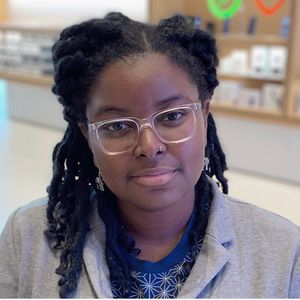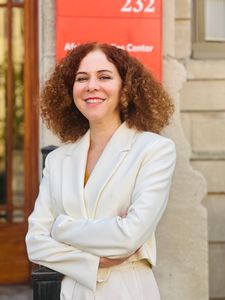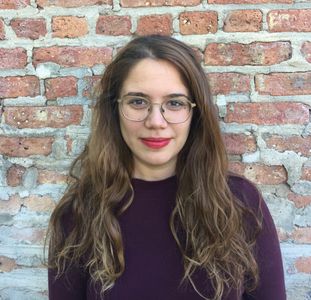Capillary Livelihoods; Q&A about New CFD Grant for Four BU Anthropologists
The Center on Forced Displacement has awarded BU anthropologists Prof. Ayşe Parla, Prof. Caterina Scaramelli, Kendra Gimblet, and Alize Arican an inaugural CFD seed grant for their project, Capillary Livelihoods: Histories of Displacement and the Cultivation of Digital, Ecological, and Communal Lifeworlds on and off Istiklal Street, Istanbul. We sat down with the brilliant team to learn more about this exciting new project.
Ayşe Parla is an Associate Professor of Anthropology and serves as the Provost’s Faculty Fellow for Graduate Academic Programs and Policies . Her primary research is on migration, dispossession, and the afterlives of the Armenian genocide.
Caterina Scaramelli is a Research Assistant Professor of Anthropology and Earth & Environments. Her research focuses on the intersection between human and non-human livelihoods with ecology, scientific knowledge, morals, and infrastructure.
Kendra Gimblet is Sociocultural Anthropology Ph.D. Student at Boston University, matriculated in Fall 2021. Her research focuses on forced migration and reconstruction of identities and livelihoods.
Alize Arican is a Postdoctoral Scholar in the Society of Fellows at BU Arts & Sciences. Her research centers on political anthropology, migration, care, and urban life. Her current project focuses on these issues within the Tarlabaşı neighborhood of Istanbul.
Provide some background information about your project. What is the focus of it, and what are you doing with it?
Kendra: Our project title is, Capillary Livelihoods: Histories of Displacement and the Cultivation of Digital, Ecological, and Communal Lifeworlds on and off Istiklal Street, Istanbul.
 The term "livelihoods" is most typically used to refer to the assets, capabilities, and activities that are required to sustain life. This particular definition of “livelihoods” enables the UNHCR, for example, to prioritize the economic inclusion of and sustainable living for migrants and refugees in the host country. But our project proposes a more capacious lens to understand how displaced communities build meaningful lives in Istanbul. We coin the term “capillary livelihoods” to address the racialized histories that shape and constrain migrant and minoritized lives, the digital worlds displaced groups participate in, the community networks they build, and the everyday practices they cultivate in relation to the built environment.
The term "livelihoods" is most typically used to refer to the assets, capabilities, and activities that are required to sustain life. This particular definition of “livelihoods” enables the UNHCR, for example, to prioritize the economic inclusion of and sustainable living for migrants and refugees in the host country. But our project proposes a more capacious lens to understand how displaced communities build meaningful lives in Istanbul. We coin the term “capillary livelihoods” to address the racialized histories that shape and constrain migrant and minoritized lives, the digital worlds displaced groups participate in, the community networks they build, and the everyday practices they cultivate in relation to the built environment.
Explain a little bit about the CFD grant.
Kendra: The Center on Forced Displacement (CFD) supports research and engagement with forced displacement and humanitarian emergencies that is truly interdisciplinary and of the highest scholarly and ethical standards. The CFD seed grant we received in the amount of $20,000 funds interdisciplinary and collaborative research.
How did the four of you all get involved with this collaborative project? What is each of your specific roles and areas in the project?
 Ayşe: The day that I received the call for proposals from the Center on Forced Displacement, I had just had a regular check-in with Kendra on the progress of her very exciting Ph.D. Project on Syrian refugees’ digital livelihood strategies in Istanbul. At the same time, I was already in a deep conversation with Alize, our brilliant postdoctoral scholar in BU’s inaugural cohort of Society of Fellows, on the importance of situating contemporary urban transformation projects in Istanbul within Turkey’s broader history of violence and dispossession, from the Armenian Genocide to the ensuing confiscation of property belonging to Armenian, Jewish, and Greek communities. Finally, I have been very interested in the new, fascinating project my colleague Caterina is pursuing on ecological livelihoods in Turkey. So, I thought, what an incredible opportunity to think alongside of one another as we each continue to pursue our individual research, to share our findings with each other on a systematic basis, and as we do so, finetune this concept of “capillary livelihoods” we are all approaching from different angles.
Ayşe: The day that I received the call for proposals from the Center on Forced Displacement, I had just had a regular check-in with Kendra on the progress of her very exciting Ph.D. Project on Syrian refugees’ digital livelihood strategies in Istanbul. At the same time, I was already in a deep conversation with Alize, our brilliant postdoctoral scholar in BU’s inaugural cohort of Society of Fellows, on the importance of situating contemporary urban transformation projects in Istanbul within Turkey’s broader history of violence and dispossession, from the Armenian Genocide to the ensuing confiscation of property belonging to Armenian, Jewish, and Greek communities. Finally, I have been very interested in the new, fascinating project my colleague Caterina is pursuing on ecological livelihoods in Turkey. So, I thought, what an incredible opportunity to think alongside of one another as we each continue to pursue our individual research, to share our findings with each other on a systematic basis, and as we do so, finetune this concept of “capillary livelihoods” we are all approaching from different angles.
So, drawing on the idea of “digital togetherness,” Kendra will investigate the virtual mobility of Syrian migrant networks through the use of Whatsapp and Instagram as everyday digital livelihood strategies. She is particularly interested in how communal bonds are maintained in situations of protracted displacement and the innovative techniques migrants use to sustain community. Alize will explore how Black Istanbulites stake claims to the city by creating everyday spaces and networks, paying special attention to Black spaces in the side streets of the main Istiklal Street, including nightclubs, community spaces, informal restaurants and shops by West African migrants, all against the backdrop of anti-Black migration policies that deny West Africans political recognition. Not dissimilar to the disavowals of anti-Black racism, Turkey officially denies the Armenian Genocide and the dispossession of its survivors. As part of my ongoing book project on the afterlives of the Armenian Genocide, I will be focusing, for this research, on three sites on and off of Istiklal Street: a vibrant Armenian church, an unkempt office complex that used to be a famous meeting point and intellectual hub, and an abandoned, decrepit building that was once an Armenian school. Finally, bringing the question of livelihoods squarely into the realm of ecology, Caterina will pursue how dispossessed and displaced communities craft livelihood strategies through everyday practices of caring for, harvesting, and exchanging vegetables and non-edible plants on windows, balconies, and makeshift urban gardens.

Caterina: When Ayşe reached out to me with an invitation to join a group conversation to design this collaborative project, I was so excited! My current work on ecological livelihood in Turkey needed to be recalibrated with more attention to urban politics and the intersecting histories and experiences of dispossessions and displacement that I felt my current approach as a solo scholar was not sufficiently engaging with. So I look at capillary plant-human livelihoods. Plants are both organisms that travel with people and companions that are left behind. They can also be agents of displacement (think of the large, industrial mono-crop plantation). Urban gardens can provide food, sociality, and a sense of home, yet they are also precarious, often ephemeral spaces. Here I take plant livelihood existing at different scales—from plants cultivated in the interstices of buildings, to the relationship with urban weeds growing in unplanned locations, to participation in more formal spaces of gardening and cultivation, to narratives and memories of loss and “home” where plants feature as symbols and material companions. My questions here are open-ended at this stage, yet connect to much more long-term work that social scientists in Turkey have conducted on the “Boston” (cultivated gardens) of Istanbul, ethnographies of urban plants, and seeds-exchanges. With a lot of cultural and political attention currently focusing on Turkey’s agricultural seed heritage and its preservation, examining everyday plant practices in the context of displacement and dispossession can challenge still common assumptions about plant belonging and “roots.”

Alize: So you can see that in addition to sharing a concept of mutual interest— capillary livelihoods— we also share a location of interest, Istiklal Street. This is a location which our respective research has already led each of us to. It is indeed one of the most well-known tourist attractions in Istanbul, a central entertainment and shopping district. It also bears the marks of the violent history of multiple processes of dispossession. Istiklal and its surrounding neighborhoods are the targets of contemporary urban transformation projects, including one that led to the famous Gezi Park uprising of 2013. And Istiklal has been home to internally displaced minorities in Turkey, like Kurds, alongside relatively newer migrants from West Africa, Central Asia, and Syrian refugees.
Kendra: We take Istiklal Street and its side streets as sites that bear the marks of dispossession and displacement, sites where lives have been uprooted, and livelihoods devastated. At the same time, we want to make visible how people build lives around, despite, and in defiance of these processes. The concept of “capillary livelihoods” we propose thus embodies a geographic approach: we view Istiklal Street as a main artery sustained by the multiple, infinitesimal side streets and districts that branch out from and feed into it. Centering the side streets, we believe, will bring visibility to the capillary ways in which livelihoods take shape.
Ayşe: Also crucial on my end in crafting the research design was that we would each pursue our individual pieces of the project as independent principal investigators, at the same time as we worked alongside each other. And we wrote the grant proposal itself in that spirit of collaboration. Looking forward, each of us will be conducting fieldwork in July 2023 in a “capillary area” around Istiklal Street, drawing on our existing engagements and ongoing work with displaced or dispossessed communities. Each of these four initiatives will serve as vectors toward a collaborative, holistic, and multidimensional analysis of livelihoods. We will convene as a team every week to share our findings during the fieldwork and continue the analysis and the conversation through regular group meetings after we get back to Boston in the Fall.
The concept of “capillary livelihoods” we propose thus embodies a geographic approach: we view Istiklal Street as a main artery sustained by the multiple, infinitesimal side streets and districts that branch out from and feed into it. Centering the side streets, we believe, will bring visibility to the capillary ways in which livelihoods take shape.
What are you most excited about with this grant/project?
Alize: It's hard to pin down what excites me most, but I can offer two thoughts. First, I am very excited about the opportunity to devote this summer to fieldwork, generously enabled by this grant. During my doctoral research, I worked closely with West African communities in Istanbul, yet this grant will give me some sustained time to build on those relationships and develop my second project. But besides the possibilities for my individual project, I am very excited by the unique possibilities this project provides—that is, being in conversation with Ayşe, Kendra, and Caterina's work as I think about my own, all projects that I'm equally excited about. So, I'm animated by the opportunity to think across communities, places, political issues, and environments in Istanbul with a wonderful community of anthropologists and environmentalists.
Kendra: My excitement is twofold. I am glad to be continuing my work with the Syrian communities in Istanbul, Turkiye, thanks to the CFD seed grant. I am also eager to participate in a multi-dimensional project where my work will be in conversation with that of Prof. Parla, Prof. Arıcan, and Prof. Scaramelli.
Ayşe: One of the things I really appreciated in the CFD’s call for proposals was their emphasis on learning directly from and with the communities grappling with the challenges of forced displacement. As one of the outcomes of this project, we hope to develop a digital archive in collaboration with the communities we work with and shape it according to the needs and wishes of those communities.
What can we look forward to next?
Alize: We envision this project as an ongoing conversation, starting among ourselves and continuing in dialogue with the broader intellectual community at BU. So, this project will be a starting point for a speaker series we will organize in the upcoming academic year in collaboration with the Center on Forced Displacement, focusing on methods and theories around displacement. Stay tuned for this new series in Fall 2023, where you will get to hear more about our project, as well as other research on displacement and migration across Boston!